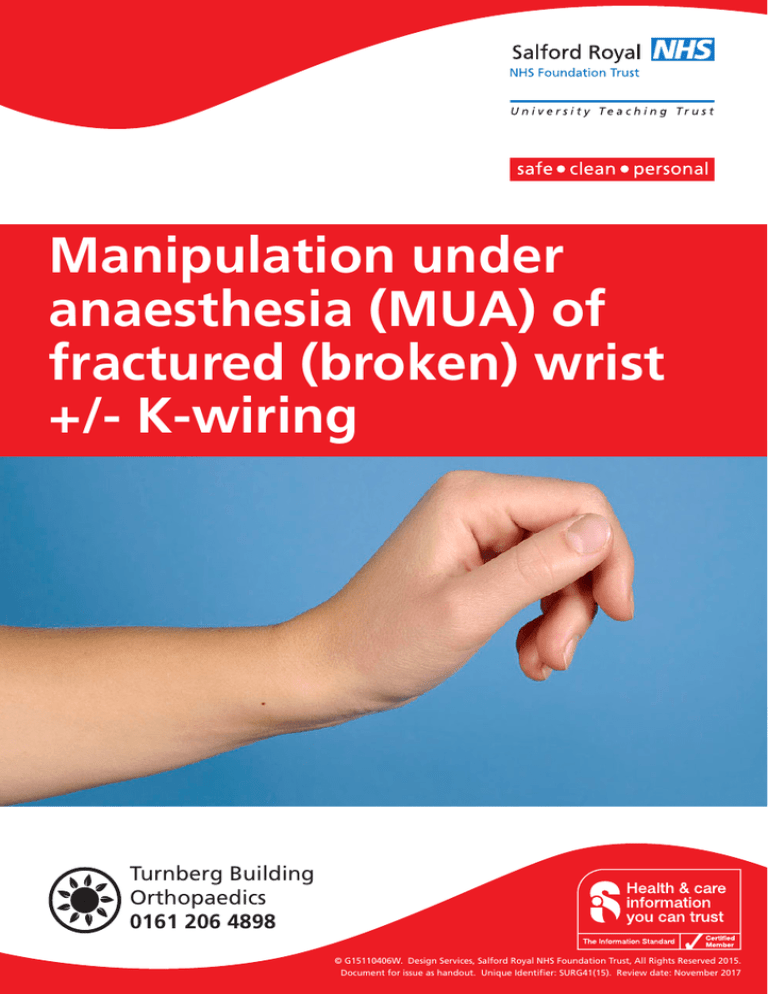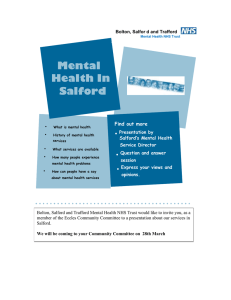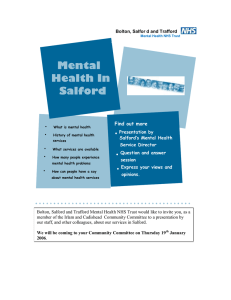
Manipulation under
anaesthesia (MUA) of
fractured (broken) wrist
+/- K-wiring
Turnberg Building
Orthopaedics
0161 206 4898
© G15110406W. Design Services, Salford Royal NHS Foundation Trust, All Rights Reserved 2015.
Document for issue as handout. Unique Identifier: SURG41(15). Review date: November 2017
Procedure
The wrist is an important
joint. When it has broken, it is
important to try and put back
into a normal position (as much
as is possible).
Your surgeons therefore feel an
operation may be necessary.
You will be given an
anaesthetic. This may be a
general (when you are asleep)
or a regional block (where an
area is numbed, but you stay
awake). You should speak to
the anaesthetist about this and
the associated risks.
In theatre, your skin will
be cleaned with anti-septic
solution and covered with clean
towels (drapes). The surgeon
will then ask for x-rays to be
taken of the broken wrist
and will attempt to “move”
(manipulate) the bones in to
the original position. Regular
x-rays will be taken to see how
the bones look.
1
Alternative procedure
Rare (<1%)
When satisfied, the surgeon
can place your wrist in a plaster
cast to keep it stable. However,
if it is felt that the fracture is
still unstable, they will progress
to placing Kirschner wires
(K-wires). These are thin wires,
which are pushed or drilled
into the bone across the break
to keep both sides stable while
healing goes on.
The fracture may be left in its
current position in a plaster. If
it is not in a good solid position,
it may not heal as well. This
will make it more likely to
develop arthritis, pain and
disability.
Infection:
Even after this, the wrist may be
placed in a plaster cast for extra
support.
Risks
When you wake up, your arm
will feel sore. This is normal. It
is extremely important that you
keep your arm up (elevated for
the next week at least). This
will help bring the swelling
down. The cast can be removed
after 6 weeks and the wires
removed earlier if appropriate.
Please be aware that a surgeon
other than the consultant,
but with adequate training or
supervision may perform the
operation.
You may of course seek a
second opinion.
As with all procedures this carries
some risks and complications.
Common (1-5%)
Pain:
Unfortunately, even though
the surgeon inserts the wires
in theatre where everything is
sterile, and your skin is cleaned,
there is still a small percent
of patients who develop an
infection. Most infections will
present as redness, swelling
or even a discharge of fluid
or pus. A course of antibiotic
may be needed. If the infection
is severe, removal of wires or
a further operation may be
necessary.
Neurovascular damage:
Your wrist will be sore after the
operation. Keeping the arm
up (elevated) most of the time
will help reduce the pain and
swelling. We will also give you
pain killers. If you need more,
however, please ask a member
of staff.
There are numerous blood
vessels and nerves that run
through and around the wrist.
This means that they may be
damaged by the wires as they
are put in. This might lead
to numbness or weakness
of muscles. This may be
temporary or in very rare cases,
permanent.
© G15110406W. Design Services, Salford Royal NHS Foundation Trust,
All Rights Reserved 2015. Document for issue as handout.
Unique Identifier: SURG41(15). Review date: November 2017
2
Notes
Compartment syndrome:
Arthritis:
This is a build up pressure
within the forearm and can
cause pain, nerve damage,
blood vessel damage and
muscle damage. If this occurs,
an emergency operation will
have to be performed to
prevent death of the hand /
forearm muscles.
And stiffness at the wrist
or elbow may occur despite
adequate reduction. Arthritis
may be more common if the
fracture involves the joint.
Slipped position:
CRP syndrome:
This is pain, swelling or stiffness
around the fracture site and
may occur even months or years
after the original injury.
Despite manipulation and cast
application, the fracture may
still slip (even after K-wiring
has been performed). Further
operation may be necessary.
It can take up to 6 months for
the swelling in the wrist to go
down.
Removal of wires:
Stiffenss:
The wires will usually be
removed after 3 to 6 weeks,
once the break has set. This
can usually be done in a clinic
without any anaesthesia.
It doesn’t hurt but feel
uncomfortable and strange.
3
Swelling:
The wrist will almost certainly
be stiff when you come out
of the cast. You may need
physiotherapy or occupational
therapy to help regain the
movement. It’s important that
you move your fingers and
elbow (if free) even when they
are in the cast.
© G15110406W. Design Services, Salford Royal NHS Foundation Trust,
All Rights Reserved 2015. Document for issue as handout.
Unique Identifier: SURG41(15). Review date: November 2017
4
© G15110406W. Design Services
Salford Royal NHS Foundation Trust
All Rights Reserved 2015
This document MUST NOT be photocopied
Information Leaflet Control Policy:
Unique Identifier: SURG41(15)
Review Date: November 2017
For further information on this leaflet, it’s references and sources
used, please contact 0161 206 4898
If you need this interpreting please telephone
Copies of this information are
available in other languages
and formats upon request.
In accordance with the
Equality Act we will make
‘reasonable adjustments’
to enable individuals with
disabilities, to access this
treatment / service.
Email: InterpretationandTrans@srft.nhs.uk
Under the Human Tissue Act 2004, consent will not be required
from living patients from whom tissue has been taken for
diagnosis or testing to use any left over tissue for the following
purposes: clinical audit, education or training relating to human
health, performance assessment, public health monitoring and
quality assurance.
If you object to your tissue being used for any of the above
purposes, please inform a member of staff immediately.
Salford Royal
operates a
smoke-free policy.
For advice on stopping
smoking contact
the Hospital Specialist
Stop Smoking Service
on 0161 206 1779
Salford Royal NHS Foundation Trust
Stott Lane, Salford,
Manchester,
M6 8HD
If you would
like to become a
Foundation Trust
Member please visit:
If you have any suggestions
as to how this document
could be improved in the
future then please visit:
Telephone 0161 789 7373
www.srft.nhs.uk/
for-members
http://www.srft.nhs.uk/
for-patients
www.srft.nhs.uk



